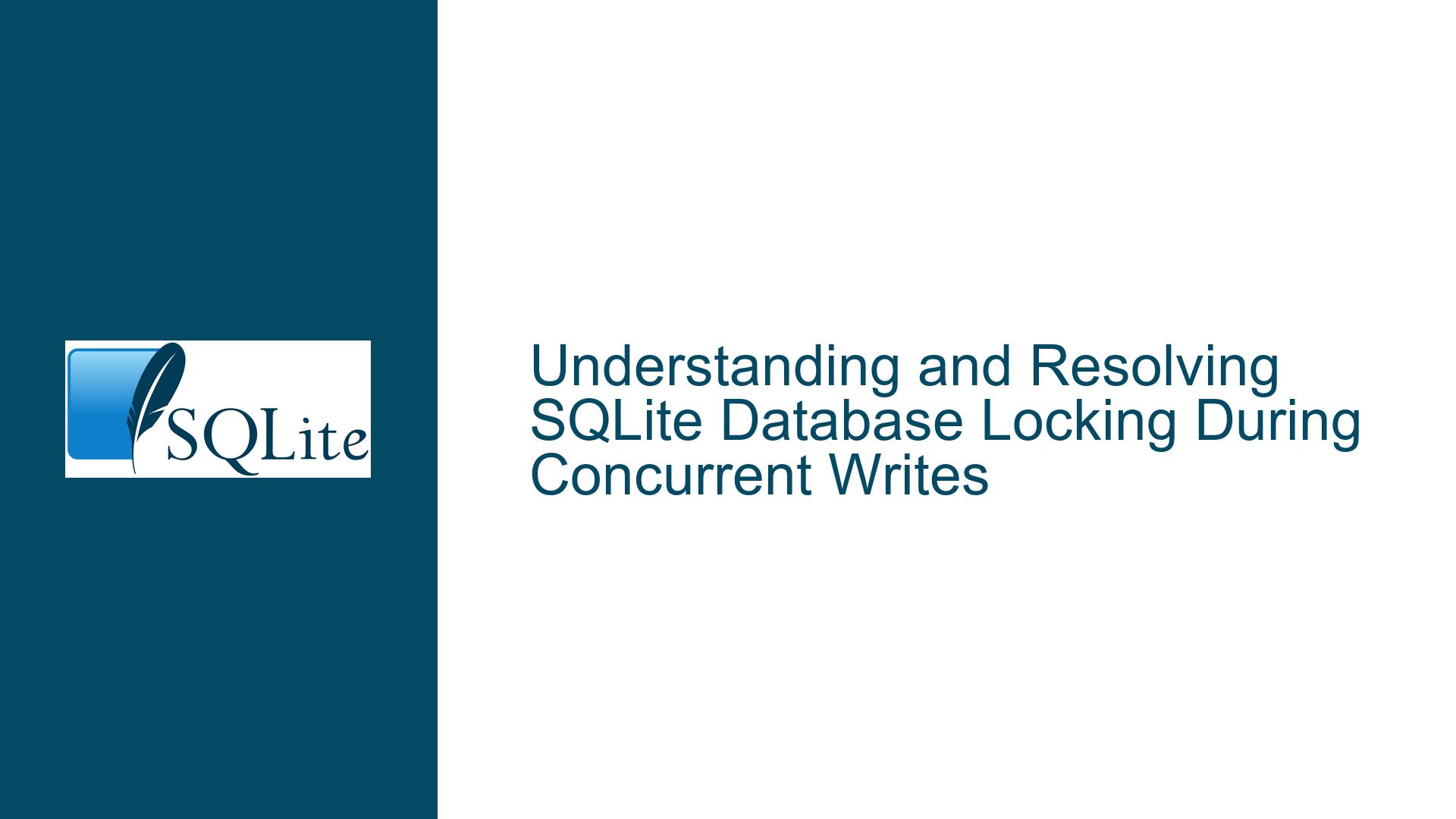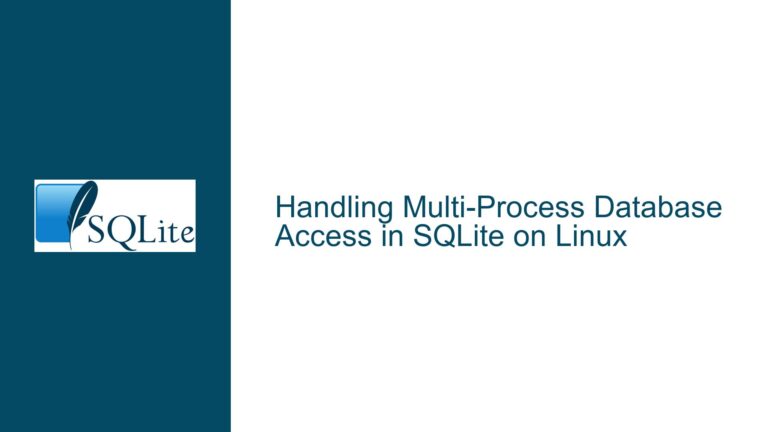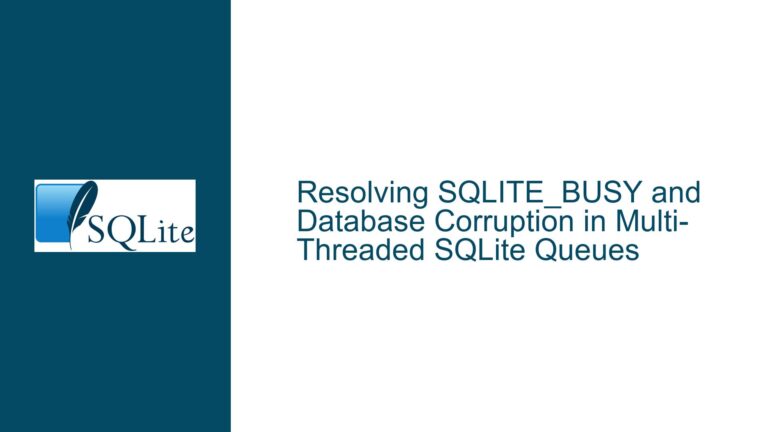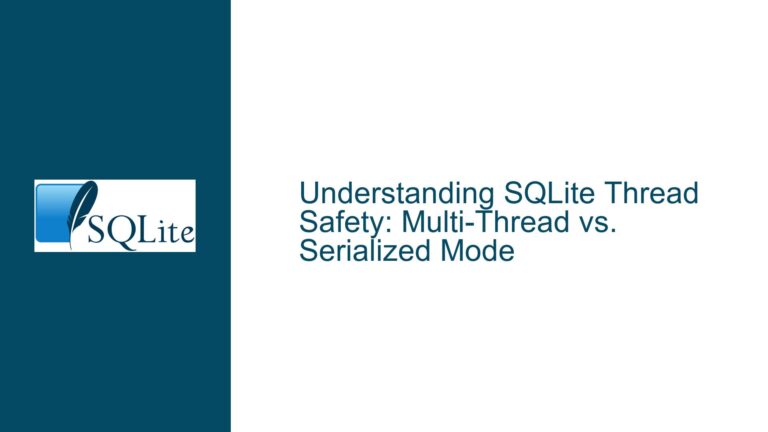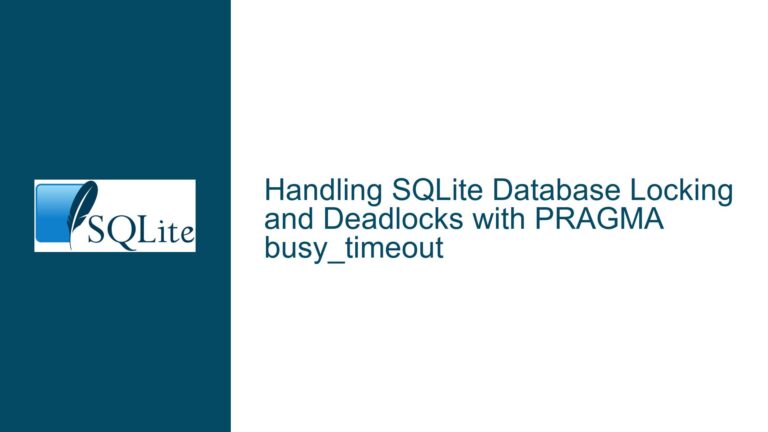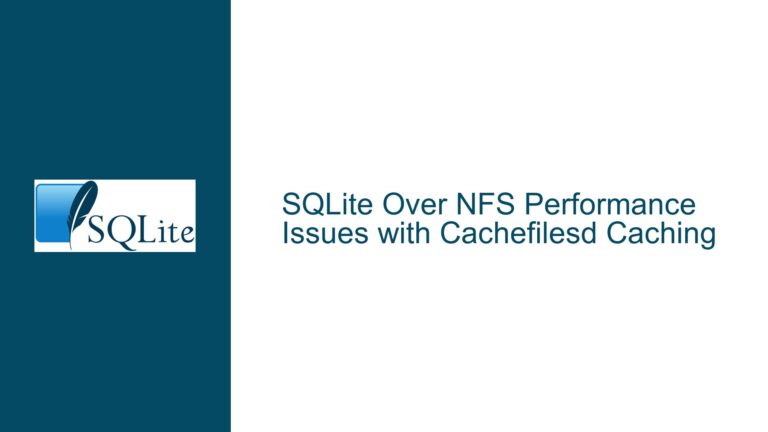and Resolving SQLite Database Locking During Concurrent Writes
Database Locking in SQLite: Managing Concurrent Write Operations
SQLite Concurrency Model and Transaction Isolation Fundamentals
SQLite is a widely-used embedded relational database management system known for its simplicity, portability, and zero-configuration design. A critical aspect of its operation that frequently causes confusion among developers is its approach to concurrent database access, particularly regarding write operations. This analysis examines the core mechanisms behind SQLite’s concurrency control and provides comprehensive solutions for resolving "database is locked" errors during parallel write attempts.
At its foundation, SQLite implements a file-based locking mechanism that follows a multiple-readers/single-writer (MRSW) model. This design allows multiple processes to read from the database simultaneously but restricts write access to exclusive use. The locking protocol operates through several distinct states:
- UNLOCKED: No connection holds any locks
- SHARED: One or more connections are reading
- RESERVED: A connection intends to write (prepares for modification)
- PENDING: Waiting to promote to exclusive lock
- EXCLUSIVE: Actively writing to the database
The transition between these states is managed through a combination of POSIX advisory locks (on Unix-like systems) and Windows locking primitives, with careful coordination to maintain ACID compliance. When two processes attempt concurrent write operations, the first process to acquire the RESERVED lock blocks subsequent writers until it completes its transaction and releases the lock.
This locking strategy creates specific behavior patterns:
- Read operations (SELECT) acquire SHARED locks
- Write operations (INSERT/UPDATE/DELETE) require promotion to EXCLUSIVE locks
- Automatic retry logic is disabled by default
- Transaction scope directly impacts lock duration
The "database is locked" error (SQLITE_BUSY) occurs when a connection cannot acquire the required lock within its operational constraints. This situation commonly arises in scenarios with multiple concurrent writers, long-running transactions, or improper isolation levels.
Primary Contributors to Lock Contention in Write-Heavy Workloads
Three fundamental factors contribute to lock contention and subsequent errors in SQLite write operations:
1. Default Locking Configuration Without Busy Timeouts
SQLite’s default configuration immediately returns SQLITE_BUSY when encountering a locked resource rather than queuing or retrying requests. This behavior stems from the database engine’s design philosophy prioritizing simplicity and predictability over automatic conflict resolution. Without explicit configuration, concurrent write attempts from separate processes will collide at the filesystem locking level, resulting in immediate errors.
2. Use of DELETE Journal Mode (Default Rollback Journal)
The traditional rollback journal mechanism (DELETE mode) employs a strict write-lock hierarchy that requires exclusive access during transaction commits. In this mode:
- Writers must obtain an exclusive lock before modifying the database
- Readers check the journal file before accessing data
- Pending writes block new readers during commit phases
- Concurrent writers cannot queue operations effectively
This journaling approach creates significant contention points when multiple processes attempt to modify the database simultaneously, particularly with numerous small transactions.
3. Transaction Scope and Isolation Mismatches
Improper transaction boundaries exacerbate locking issues through:
- Long-held write locks from unbounded transactions
- Implicit auto-commit behavior between statements
- Mixing transactional and non-transactional operations
- Failure to properly handle rollback scenarios
When scripts execute individual INSERT statements without explicit transaction blocks, each statement becomes an auto-committed transaction. This pattern dramatically increases lock contention by requiring exclusive lock acquisition for every single insert operation.
Comprehensive Strategy for Managing Concurrent Access
1. Enable Write-Ahead Logging (WAL) Journal Mode
Transitioning to WAL mode fundamentally alters SQLite’s concurrency characteristics:
PRAGMA journal_mode=WAL;
Key advantages of WAL mode include:
- Readers and writers can operate concurrently
- Writers append to a separate WAL file rather than modifying main database
- Checkpointing occurs separately from write operations
- Reduced frequency of EXCLUSIVE lock requirements
Implementation considerations:
- Requires SQLite 3.7.0 or newer
- WAL files must remain on same filesystem as main database
- Not compatible with network filesystems in most cases
- Use
.wal_checkpointpragma to manage WAL size
2. Configure Appropriate Busy Timeouts
Implement automatic retry logic through busy_timeout pragma:
PRAGMA busy_timeout = 30000; -- 30 second timeout
This setting:
- Enables built-in retry logic for locked resources
- Accepts timeout in milliseconds
- Should be set per-connection
- Works with both WAL and rollback journal modes
3. Optimize Transaction Management
Explicit transaction control reduces lock contention:
BEGIN IMMEDIATE;
-- Multiple insert statements
COMMIT;
Transaction best practices:
- Use BEGIN IMMEDIATE for write transactions
- Keep transactions as short as possible
- Batch multiple operations within single transactions
- Avoid interleaving read/write operations in long transactions
- Use SAVEPOINT for complex transactional logic
4. Connection Pooling and Process Coordination
When using multiple processes:
- Implement a connection pool per process
- Use application-level queueing for write operations
- Consider using an external locking mechanism for critical sections
- Explore client/server wrappers like
sqlite3_multiprocessif heavy concurrency required
5. Monitor and Analyze Locking Behavior
Utilize SQLite’s operational statistics:
PRAGMA compile_options; -- Verify WAL support
PRAGMA locking_mode; -- Check journal mode
SELECT * FROM sqlite_master WHERE type='table'; -- Check schema locks
6. Advanced Configuration Options
For specialized use cases:
- Set
PRAGMA synchronous=NORMALfor faster writes (with WAL) - Adjust WAL autocheckpoint threshold:
PRAGMA wal_autocheckpoint=1000; -- Pages before auto-checkpoint - Consider
PRAGMA journal_size_limitfor WAL size management
7. Handling Lock Exceptions Programmatically
Implement retry logic in application code:
import sqlite3
import time
def execute_with_retry(db, query, max_retries=5, delay=0.1):
for attempt in range(max_retries):
try:
return db.execute(query)
except sqlite3.OperationalError as e:
if "database is locked" in str(e):
time.sleep(delay * (2 ** attempt))
else:
raise
raise sqlite3.OperationalError("Max retries exceeded")
8. Alternative Approaches for High Concurrency
When native SQLite concurrency proves insufficient:
- Use in-memory databases for temporary data
- Implement sharding across multiple database files
- Explore SQLite extensions like
sqleetfor enhanced locking - Consider alternative storage engines (e.g., RocksDB) with different concurrency models
Through careful configuration of journal modes, transaction boundaries, and timeout settings, developers can achieve robust concurrent write performance in SQLite while maintaining data integrity. The combination of WAL mode, appropriate busy timeouts, and optimized transaction handling typically resolves "database is locked" errors in most practical scenarios. For extreme write concurrency requirements, architectural changes combining SQLite with application-level queuing or alternative storage systems may become necessary.
